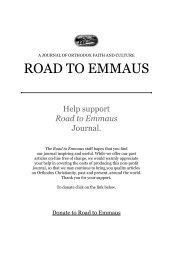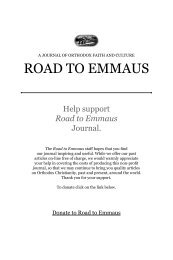RTE No 20 Interior - Road to Emmaus Journal
RTE No 20 Interior - Road to Emmaus Journal
RTE No 20 Interior - Road to Emmaus Journal
You also want an ePaper? Increase the reach of your titles
YUMPU automatically turns print PDFs into web optimized ePapers that Google loves.
<strong>Road</strong> <strong>to</strong> <strong>Emmaus</strong> Vol. VI, <strong>No</strong>. 2 (#21)FROM JAINISM TO ORTHODOXYFor example, in the inner city everyone lives in gated communities, verysmall communities with a big wall around a number of houses. They havetiny streets – you can’t get a car in there – and all of the houses are rathertall and narrow. Each community has its own temple or mosque, dependingon whether it’s a Jain, Hindu, or Moslem community. During the partitioning,however, when there were Hindu-Muslim riots, my aunt says thatmany Muslims <strong>to</strong>ok in Hindus and Hindus <strong>to</strong>ok in Muslims. They protectedeach other, because they realized that this was a political battle that hadnothing <strong>to</strong> do with religion or the people living next <strong>to</strong> them. They had beenliving with these Muslims and Hindus for generations, for centuries. Theywere neighbors, and loved each other just as they loved their own families.<strong>RTE</strong>: Was your family near the Pakistani border during the fighting?ELESA: Yes. Ahmedabad is in Gujarat, and Gujarat borders Pakistan. Thecity is about <strong>20</strong>0 kilometers away from the border. There was more violencein the area of Punjab, because Gujarat’s border area is in the middle of thedesert and there weren’t many people living there. But when people talkabout the time of partition, it wasn’t really about Muslims against Hindusor Hindus against Muslims, it was an overall political scheme, the Britishstrategy <strong>to</strong> divide and rule: “Divide the Muslims and Hindus, divide thepeople, divide the land.”My mother’s father also knew Gandhi. When my mother was three,grandfather <strong>to</strong>ok her and her six-year-old brother in his horse and buggy <strong>to</strong>meet Gandhi. My uncle presented him with a hand-made rope of sugarcanereeds; one of Gandhi’s most cherished projects was encouraging localsustainable handicrafts. My mother gave him a mango, which he sharedwith her, or at least <strong>to</strong>ok it, blessed it, and gave it back. The feeling that Ihave when I speak with the older members of my family was that he was awonderful man. He had an immense love for children; being with childrenwas nourishment for his soul and inspired him <strong>to</strong> push forward, <strong>to</strong> save thefuture for the children of India.<strong>No</strong>t only India’s independence, but many of the social reforms we’ve made(for instance in the caste system) were instigated by Gandhi, and people stillhonor him for it. They don’t pray <strong>to</strong> him as a saint, but they very much reverehim. When he was shot, his dying words were, “Hai Ram,” which means “OLord!” and they’ve put up a little black granite pavilion on the shore of theGanges with “Hai Ram” inscribed on it as a memorial. His birthday, Oc<strong>to</strong>ber 2,is a holiday in India, and people go there <strong>to</strong> pray for him and <strong>to</strong> give offeringsand flowers in thanksgiving for his life. He is very loved.Politically, the Indians around him were also important. They believed inGandhi and saw him as their leader, but they were also very learned themselvesand had the interests of the country at heart. Some say that <strong>to</strong>wardsthe end Gandhi was more of a symbol, and others were wielding the politicalpower.<strong>RTE</strong>: But that would have been in line with Gandhi’s whole approach. Hissights were on higher things than personal political power.ELESA: Right. He didn’t really care who ran the government as long as it wasa peaceful government and the people were happy. This is why, when theIndia-Pakistan partition occurred, it broke his heart that his people werebeing separated. At that point, Jawaharlal Nehru, who had backed the partition,was slated <strong>to</strong> become the Indian prime minister, but Gandhi askedhim <strong>to</strong> step down and give the post <strong>to</strong> Muhammed Ali Jinnah. Jinnah didn’taccept, however, and Nehru came <strong>to</strong> power anyway.<strong>RTE</strong>: Has the Ahimsa movement continued and does Gandhi’s ashram inAhmedabad still exist?ELESA: The ashram in Ahmedabad has been turned in<strong>to</strong> a museum, butthere are other communities that have taken on aspects of Gandhi’s work;for example, the inequalities of the Hindu caste system, which has been ahorrid thing for many people.<strong>RTE</strong>: Do Jains also have castes?ELESA: Theoretically, no. The caste system is Hindu. Neither Jains norMuslims have castes, but because the Jains are usually merchants they arerelegated <strong>to</strong> the merchant class in Hinduism. We are artificially placed in<strong>to</strong>their hierarchy. But the people at the very bot<strong>to</strong>m of the Hindu caste system,the Shudras, the Un<strong>to</strong>uchables, are the so-called “backward” class. This wasa huge problem for Gandhi. He could not believe that such a pious country,with everything we teach about loving our neighbor and doing good deeds,could treat these people so badly.<strong>RTE</strong>: In speaking against it, Gandhi was overturning a five thousand-yearoldtradition. Was he the first <strong>to</strong> do this?<strong>20</strong>21










